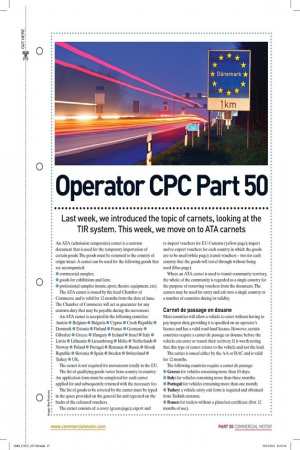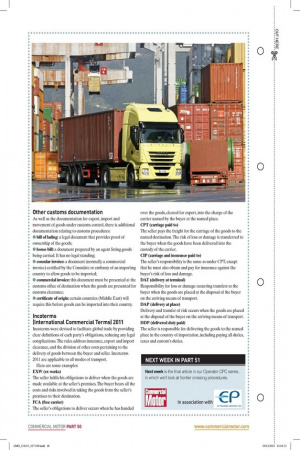Operator CPC Part 50
Page 20

Page 21

If you've noticed an error in this article please click here to report it so we can fix it.
Last week, we introduced the topic of carnets, looking at the TIR system. This week, we move on to ATA carnets An ATA (admission temporaire) carnet is a customs document that is used for the temporary importation of certain goods. The goods must be returned to the country of origin intact. A carnet can be used for the following goods that are accompanied: • commercial samples; • goods for exhibitions and fairs;
• professional samples (music, sport, theatre equipment, etc).
The ATA carnet is issued by the local Chamber of Commerce and is valid for 12 months from the date of issue. The Chamber of Commerce will act as guarantor for any customs duty that may be payable during the movement.
An ATA carnet is accepted in the following countries: Austria • Belgium • Bulgaria • Cyprus • Czech Republic • Denmark • Estonia • Finland • France • Germany • Gibraltar • Greece • Hungary • Ireland • Israel • Italy • Latvia • Lithuania • Luxembourg • Malta • Netherlands • Norway • Poland • Portugal • Romania • Russia • Slovak Republic • Slovenia • Spain • Sweden • Switzerland • Turkey • UK.
The carnet is not required for movements totally in the EU.
The list of qualifying goods varies from country to country. An application form must be completed for each carnet applied for and subsequently returned with the necessary fee.
The list of goods to be covered by the carnet must be typed in the space provided on the general list and repeated on the backs of the coloured vouchers. The carnet consists of: a cover (green page); export and
re-import vouchers for EU Customs (yellow page); import and re-export vouchers for each country in which the goods are to be used (white page); transit vouchers — two for each country that the goods will travel through without being used (blue page).
Where an ATA carnet is used to transit community territory, the whole of the community is regarded as a single country for the purpose of removing vouchers from the document. The carnets may be used for entry and exit into a single country or a number of countries during its validity. Carnet de passage en douane
Most countries will allow a vehicle to enter without having to pay import duty, providing it is specified on an operator's licence and has a valid road fund licence. However, certain countries require a carnet de passage en douane before the vehicle can enter or transit their territory. It is worth noting that this type of carnet relates to the vehicle and not the load.
The carnet is issued either by the AA or RAC and is valid for 12 months. The following countries require a carnet de passage: • Greece: for vehicles remaining more than 10 days; • Italy: for vehicles remaining more than three months; • Portugal: for vehicles remaining more than one month; • Turkey: a vehicle entry-exit form is required and obtained from Turkish customs;
• France: for trailers without a plate/test certificate (first 12 months of use). Other customs documentation As well as the documentation for export, import and movement of goods under customs control, there is additional documentation relating to customs procedures: • bill of lading: a legal document that provides proof of ownership of the goods; • house bill: a document prepared by an agent listing goods being carried. It has no legal standing; • consular invoice: a document (normally a commercial invoice) certified by the Consulate or embassy of an importing country to allow goods to be imported; • commercial invoice: this document must be presented at the customs office of destination when the goods are presented for customs clearance;
• certificate of origin: certain countries (Middle East) will require this before goods can be imported into their country. Incoterms (International Commercial Terms) 2011
Incoterms were devised to facilitate global trade by providing clear definitions of each party's obligations, reducing any legal complications. The rules address insurance, export and import clearance, and the division of other costs pertaining to the delivery of goods between the buyer and seller. Incoterms 2011 are applicable to all modes of transport. Here are some examples: EXW (ex works)
The seller fulfils his obligations to deliver when the goods are made available at the seller's premises. The buyer bears all the costs and risks involved in taking the goods from the seller's premises to their destination. FCA (free carrier) The seller's obligations to deliver occurs when he has handed
over the goods, cleared for export, into the charge of the carrier named by the buyer at the named place. CPT (carriage paid to)
The seller pays the freight for the carriage of the goods to the named destination. The risk of loss or damage is transferred to the buyer when the goods have been delivered into the custody of the carrier. CIP (carriage and insurance paid to)
The seller's responsibility is the same as under CPT, except that he must also obtain and pay for insurance against the buyer's risk of loss and damage. DAT (delivery at terminal)
Responsibility for loss or damage occurring transfers to the buyer when the goods are placed at the disposal of the buyer on the arriving means of transport. DAP (delivery at place) Delivery and transfer of risk occurs when the goods are placed at the disposal of the buyer on the arriving means of transport. DDP (delivered duty paid)
The seller is responsible for delivering the goods to the named place in the country of importation, including paying all duties, taxes and custom's duties.







































